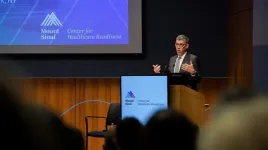(Press-News.org) Endoscopes are instruments that are used to look inside the body
Even with new developments cleaning them sufficiently has been a challenge
The University has entered a knowledge transfer partnership (KTP) with PFE Medical to improve the process by removing bacterial biofilm inside them.
Aston University experts are teaming up with a medical products company to improve the cleaning of endoscopes.
Endoscopes are long, thin instruments with a light and camera at one end that are used to look inside the body.
Cleaning them sufficiently has been a challenge and even with new developments they can still end up with a bacterial biofilm inside them.
The University will be collaborating with Stoke-on-Trent-based PFE Medical on a Knowledge Transfer Project (KTP) to assess if fibreoptic probes carrying ultraviolet (UV) light can detect biofilms. If successful they will use this to develop a world-first device to inspect devices and clear them for use, improving patient safety.
A KTP is a three-way collaboration between a business, an academic partner and a highly qualified researcher, known as a KTP associate. The UK-wide programme helps businesses to improve their competitiveness and productivity through the better use of knowledge, technology and skills.
Aston University is a sector leading KTP provider, with 80% of its completed projects being graded as very good or outstanding by Innovate UK, the national body.
Due to the sensitivity of the materials and electronics, endoscopes cannot be sterilised in the same way as other laboratory and medical equipment and require lengthy cleaning procedures.
Previously an award-winning KTP between the University and PFE Medical resulted in a machine known as Khamsin which dramatically improved the cleaning process. This new technology is undergoing real-world trials in the West Midlands and looks set to save the NHS significant time and money.
Even with such high-powered cleaning, endoscopes can still end up with a bacterial biofilm inside them. Biofilms are large clusters of bacteria that are attached to a surface and to each other through the production of a slime layer.
They show increased resistance to antibiotics as well as disinfectants and can therefore build up over time, even with effective cleaning and decontamination processes. Endoscopes with these resistant bacteria inside can lead to infections and even the death of patients.
Rob Hartley, Managing Director of PFE Medical said: “Biofilm is a hidden killer, and we have no way to detect it currently without completely taking apart these medical devices. There is rising concern about microbial resistance and to find a way to objectively detect bacteria would be a true innovation that would have impact around the world.”
This new KTP follows the previous work by the two organisations, combining PFE Medical’s knowledge of endoscopes with highly specialised knowledge and expertise in fibre optics at Aston University's Institute of Photonic Technologies (AIPT), a world-leading photonics research centre with a track record of success in medical lasers and bio-sensing for healthcare.
The project will be led by Professor Kate Sugden, Deputy Dean of the School of Engineering & Applied Sciences who has significant experience in both industry and academia. One of her main research focus areas is on fibre optic sensing systems and she has worked as a director for two fibre optic companies. She said: “It was exciting to go to PFE Medical recently and see Khamsin in action, knowing that this new product came from a project that only finished last year. It will be a challenge to match the success of the last project, but I am optimistic that we can draw on the combined talent and facilities once again to make a significant contribution to solving this problem.”
She will be working with Dr Tony Worthington and Dr David Benton. Dr Worthington is an Associate Professor in the College of Health and Life Sciences at Aston University and a member of the Cell & Tissue Biomedical Research Group. He brings extensive knowledge of healthcare associated infections and biofilms, and can advise on their identification for this project.
He said: “This KTP project continues the innovative and transformational work that we have done together in the endoscope cleaning and reprocessing sector. To find a way to objectively view if biofilm is present within an endoscope could be world-changing and have global impact for many patients.”
Meanwhile Dr David Benton is a Senior Research Fellow in Aston University’s AIPT. He spent many years working in industry, and his research expertise covers topics including laser detection and optical spectroscopy.
The Aston University researchers will be working with Rebecca Hartley at PFE Medical, who has been a product specialist for 10 years and is a qualified validation engineer for decontamination.
The project will run for two years and is due for completion in 2026.
For more information on the KTP visit the webpage.
END
Aston University experts team up with medical products company to help make endoscopes cleaner and safer
2024-05-20
ELSE PRESS RELEASES FROM THIS DATE:
New method to reveal what drives brain diseases
2024-05-20
LA JOLLA, CA — The brain is often referred to as a “black box”—one that’s difficult to peer inside and determine what’s happening at any given moment. This is part of the reason why it’s difficult to understand the complex interplay of molecules, cells and genes that underly neurological disorders. But a new CRISPR screen method developed at Scripps Research has the potential to uncover new therapeutic targets and treatments for these conditions.
The method, outlined in a study published in Cell on May 20, 2024, provides a way to rapidly examine the brain cell types ...
AI chips could get a sense of time
2024-05-20
Image
Artificial neural networks may soon be able to process time-dependent information, such as audio and video data, more efficiently. The first memristor with a 'relaxation time' that can be tuned is reported today in Nature Electronics, in a study led by the University of Michigan.
Memristors, electrical components that store information in their electrical resistance, could reduce AI's energy needs by about a factor of 90 compared to today's graphical processing units. Already, AI is projected to account for about half a percent of the world's total electricity ...
PARC model of care associated with fewer deaths among veterans post-ICU
2024-05-20
EMBARGOED UNTIL: 10:15 a.m. PT, Monday, May 20, 2024
PARC MODEL OF CARE ASSOCIATED WITH FEWER DEATHS AMONG VETERANS POST-ICU
Session: B18 – Bridging Gaps to Improve Long-Term Outcomes
The Post-Acute Recovery Center: A Telehealth Care Model to Improve Patient-Centered Outcomes for High-Risk Survivors of Critical Illness
Date and Time: Monday, May 20, 2024, 10:15 a.m. PT
Location: San Diego Convention Center, Room 32A-B (Upper Level)
ATS 2024, San Diego – Research presented at the ATS 2024 International Conference demonstrates that veterans who received ...
Department of Energy announces $6 million for isotope R&D
2024-05-20
WASHINGTON, D.C. - Today, the U.S. Department of Energy (DOE) announced $6 million in funding for 12 awards across eight efforts to advance research in isotope enrichment, targetry, and separations. This funding is part of a key federal program that produces critical isotopes otherwise unavailable or in short supply in the U.S.
Isotopes, or variations of the same elements that have the same number of protons but different numbers of neutrons, have unique properties that make them powerful in medical diagnostic and treatment applications. They are also essential for applications in quantum information science, nuclear power, national security, and more.
“These ...
World leaders still need to wake up to AI risks, say leading experts ahead of AI Safety Summit
2024-05-20
UNDER EMBARGO UNTIL 19:00 BST / 14:00 ET MONDAY 20 MAY 2024.
World leaders still need to wake up to AI risks, say leading experts ahead of AI Safety Summit
More information, including a copy of the paper, can be found online at the Science press package at https://www.eurekalert.org/press/scipak/, or can be requested from scipak@aaas.org
Leading AI scientists are calling for stronger action on AI risks from world leaders, warning that progress has been insufficient since the first AI Safety Summit in Bletchley Park six months ago.
Then, the world’s leaders pledged to govern AI responsibly. However, as the second AI Safety Summit in Seoul ...
*FREE* Managing extreme AI risks amidst rapid technological development
2024-05-20
Although researchers have warned of the extreme risks posed by rapidly developing artificial intelligence (AI) technologies, there is a lack of consensus about how to manage them. In a Policy Forum, Yoshua Bengio and colleagues examine the risks of advancing AI technologies – from the social and economic impacts, malicious uses, and the possible loss of human control over autonomous AI systems – and recommend directions for proactive and adaptive governance to mitigate them. They call on major technology companies and public funders to invest more – at least one-third of their budgets – into assessing and ...
Advancing 3D mapping with tandem dual-antenna SAR interferometry
2024-05-20
The new Tandem Dual-Antenna Spaceborne Synthetic Aperture Radar (SAR) Interferometry (TDA-InSAR) system, addresses the limitations of current spaceborne Synthetic Aperture Radar (SAR) systems by providing a more reliable and efficient method for 3D surface mapping. The system's innovative design allows for single-pass acquisitions, significantly reducing the time required for data collection and enhancing the precision of 3D reconstructions in various terrains, including built-up areas and vegetation canopies.
Synthetic Aperture Radar (SAR) interferometry (InSAR) is a powerful tool for producing high-resolution topographic maps. However, traditional InSAR techniques face ...
Mount Sinai launches Center for Healthcare Readiness to strengthen practice and partnerships in public health emergency response
2024-05-20
The Icahn School of Medicine at Mount Sinai announced the launch of its new Center for Healthcare Readiness, bringing together a diverse team of academic and operational experts to strengthen the Mount Sinai Health System’s strategies and the U.S. health care sector’s capacity to prepare for and respond to any large-scale public health emergency.
The Center will work with both Mount Sinai’s own resources, and public and private partners at the local, regional, and federal levels, to pursue strategies in research, advocacy, innovation, and collaboration to plan ...
Study sheds light on bacteria associated with pre-term birth
2024-05-20
Researchers from North Carolina State University have found that multiple species of Gardnerella, bacteria sometimes associated with bacterial vaginosis (BV) and pre-term birth, can coexist in the same vaginal microbiome. The findings add to the emerging picture of Gardnerella’s effects on human health.
Gardnerella is a group of anaerobic bacteria that are commonly found in the vaginal microbiome. Higher levels of the bacteria are a signature of BV and associated with higher risk of pre-term birth, ...
Evolving market dynamics foster consumer inattention that can lead to risky purchases
2024-05-20
CORVALLIS, Ore. – Researchers have developed a new theory of how changing market conditions can lead large numbers of otherwise cautious consumers to buy risky products such as subprime mortgages, cryptocurrency or even cosmetic surgery procedures.
These changes can occur in categories of products that are generally low risk when they enter the market. As demand increases, more companies may enter the market and try to attract consumers with lower priced versions of the product that carry more risk. If the negative effects of that risk are not immediately noticeable, the market can evolve to keep consumers ignorant of the risks, said Michelle Barnhart, an associate professor ...



